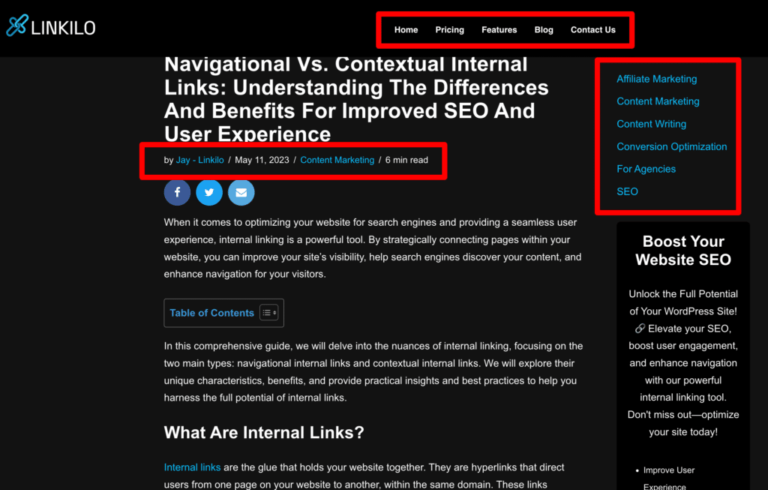Best practices for internal linking involve using relevant anchor texts and linking to content-rich pages. Maintain a logical hierarchy and avoid excessive linking on a single page.
Internal linking is crucial in enhancing user experience and SEO performance. By strategically interconnecting your webpages, you guide visitors through your website, increasing the time they spend engaged with your content. This practice also allows search engines to crawl your site more effectively, boosting your visibility in search results.
A well-planned internal linking structure helps spread link equity across pages, improving the ranking potential of individual pages. To ensure your website benefits from internal linking, it’s essential to employ thoughtful, user-focused strategies that align with SEO best practices.

Credit: www.romainberg.com
The Power Of Internal Linking In Seo
Internal linking is a key element in SEO strategy. It connects different pages of a website. This makes it easier for search engines to crawl. Internal links give certain pages more power. They send signals to search engines. These signals show which pages are important. Pages with more links can gain higher page authority.
Links help users navigate a website more easily. They find relevant information quicker. Good linking improves the overall user experience. A page linked by many others could be really helpful. That page carries weight. Users stay longer on a site if they find valuable links. This is great for SEO. Site engagement goes up. Bounce rates typically go down.
Crafting A Strategic Link Structure
Creating a strong link structure is vital for website navigation. Internal links guide users through your site in an organized way. They should follow a logical hierarchy.
Keep your link depth shallow. Aim for users to reach any page in three clicks or less. This is the ‘three-click-rule’. It makes your content easily accessible.
Choosing the right anchor text is crucial for SEO. The clickable text should be descriptive and contain relevant keywords. This helps search engines understand each link’s context, enhancing your website’s SEO performance.
Optimizing Link Placement
Ensuring content relevance is crucial as you link internally. Always link to pages that offer value and context to the reader. Think of links as paths that guide visitors to related topics or further information, improving their experience on your site.
Diverse and thoughtful link distribution supports site navigation. Spread out links to cover various relevant pages and topics. This helps prevent any single page from becoming a “link hub” while others are ignored. Each link should provide a clear benefit and enhance the user’s journey across your website.
| Strategy | Benefits |
|---|---|
| Content Relevance | Improves user experience, boosts page value |
| Link Distribution | Balances site structure, avoids page neglect |

Credit: www.bigapplemedia.com
Ensuring Link Quality And Functionality
Ensuring the quality of your internal links is crucial for a website’s health. Broken links can be harmful since they lead to dead ends for users and search engines. It is vital to use tools like Screaming Frog SEO Spider or Google Search Console to find and fix these issues promptly.
Maintaining an up-to-date link structure is equally important. Web content evolves, leading to page updates or removals. Therefore, regular audits are essential. They help in keeping the site’s navigation seamless. This task enhances both user experience and website credibility. Remember, a well-maintained internal linking strategy can significantly boost your site’s SEO performance.
Measuring The Impact Of Internal Links
To gauge the effect of internal links, scrutinize user movement through your site. Tools like Google Analytics can reveal paths visitors take, highlighting popular content and potential navigational issues. This data informs tweaks to improve user experience, aiding retention and conversion rates.
SEO performance gains emanate from strategic internal linking. Trace rank boosts to understand how these links contribute. Keep watch for upticks in page authority and better visibility in search results. Such metrics testify to the prowess of a well-linked ecosystem within your website.

Credit: hostadvice.com
Frequently Asked Questions For What Are The Best Practices For Internal Linking?
Which Is The Best Way For Internal Linking?
Use relevant anchor text for links connecting related content, ensuring it’s descriptive and concise. Link high-authority pages to improve visibility of newer or key posts. Maintain a reasonable number of links per page to enhance user experience and crawlability.
What Is The Internal Linking Strategy For 2023?
The 2023 internal linking strategy emphasizes meaningful connections between pages, user navigational ease, and distribution of page authority throughout the site to boost SEO performance.
How Do You Manage Internal Links?
To manage internal links effectively, create a structured hierarchy on your website. Use relevant anchor texts and link contextually to important pages. Regularly audit links to fix or update broken ones, and ensure they contribute to a user-friendly experience, guiding visitors to related content efficiently.
What Are Internal Linkages Examples?
Internal linkage examples include menu navigation links, links within content directing to other site pages, and sidebar or footer links to relevant articles. These connections enhance user experience and site navigation.
Conclusion
Internal linking can elevate your site’s SEO and provide a better experience for visitors. By thoughtfully integrating links within your content, you guide users and search engines through your website’s landscape. Remember that relevance, link placement, and anchor text are key.
Implementing these best practices will not only boost your SEO efforts but also enhance user engagement. Keep refining your internal linking strategy for the best results.




